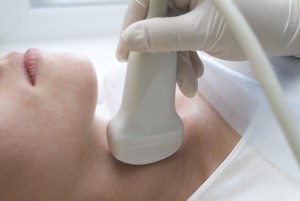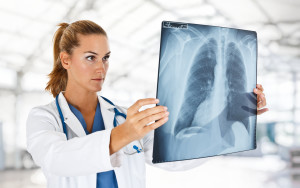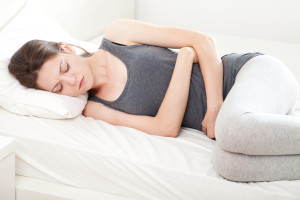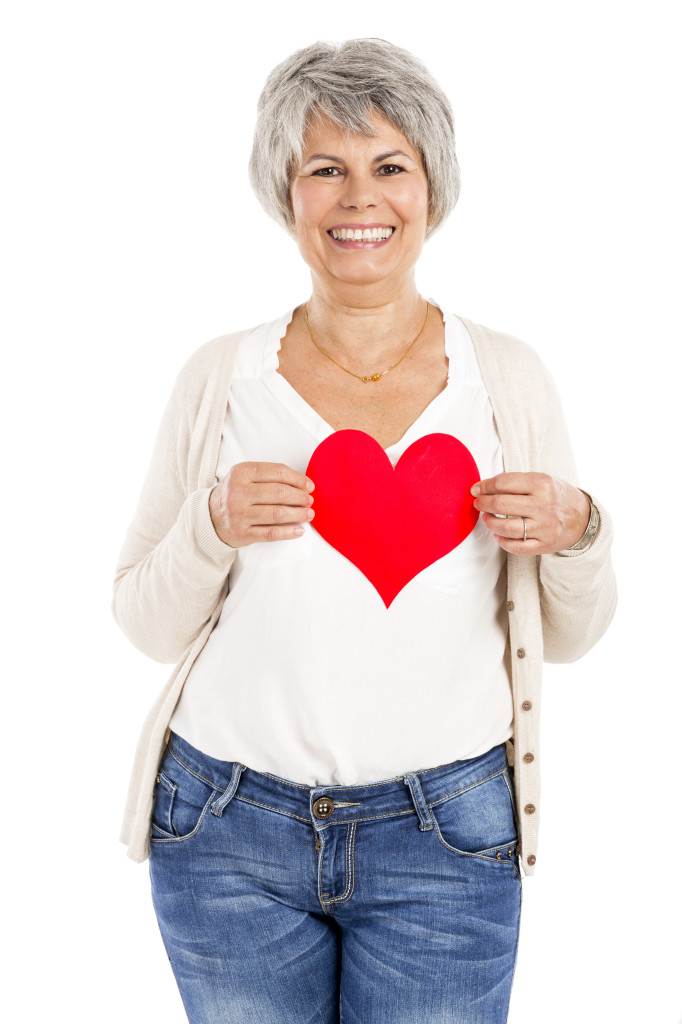Learn How a Thyroid Screening Can Save Your Life
 January is Thyroid Awareness Month, and for good reason. An estimated 20 million Americans suffer from some form of thyroid disease, and up to 60 percent are unaware of their condition. Women in particular are at risk for thyroid disease, and are five to eight times more likely than men to have thyroid problems. By understanding the symptoms and warning signs of thyroid diseases, including thyroid cancer, and committing to regular check-ups, you can reduce your risk of developing a serious health condition.
January is Thyroid Awareness Month, and for good reason. An estimated 20 million Americans suffer from some form of thyroid disease, and up to 60 percent are unaware of their condition. Women in particular are at risk for thyroid disease, and are five to eight times more likely than men to have thyroid problems. By understanding the symptoms and warning signs of thyroid diseases, including thyroid cancer, and committing to regular check-ups, you can reduce your risk of developing a serious health condition.
The Thyroid’s Role in Regulating Your Metabolism.
Your thyroid is a butterfly-shaped endocrine gland located in your neck just above your collarbone. It produces hormones that help your body regulate your metabolism. When not functioning properly, it can cause your system to accelerate, a condition known as hyperthyroidism, or decelerate, a condition known as hypothyroidism. Symptoms of hyperthyroidism include rapid weight loss, high blood pressure, anxiety and insomnia. Symptoms of hypothyroidism include a weak or slow heartbeat, muscular weakness, constant fatigue, weight gain, depression, slow reflexes, sensitivity to cold, puffy skin, slowed mental processes and poor memory, and constipation.
Thyroid Diseases.
Other thyroid diseases may include:
- Thyroid nodules – lumps in the thyroid gland
- Thyroiditis – swelling of the thyroid
- Goiter – an enlargement of the thyroid gland often causing difficulty swallowing or breathing
Thyroid Cancer.
Thyroid cancer is the fifth most common form of cancer in women. Women are at a greater risk for developing thyroid cancer if they:
- Are between ages 25 and 65
- Are Asian
- Have a family member who has had thyroid disease
- Have had radiation treatments to their head or neck
You should see a doctor if you have a lump or swelling in your neck. To test for Thyroid cancer your doctor will likely perform a physical exam, blood tests, imaging tests, and a biopsy. Treatment options depend on the type of thyroid cancer you have and how it has developed. Treatment may include surgery, radioactive iodine, hormone treatment, radiation therapy, chemotherapy, or targeted therapy.
The Benefits of Self-exams.
Examining your neck on a regular basis may help you identify lumps or enlargements that are indicative of thyroid disease. To perform a self-exam:
- Use a mirror to study the lower middle area of your neck, above the collarbones, and below the larynx.
- Tip your head back, take a drink of water, and swallow.
- Look at your neck and check for any bulges near your collarbone.
If you do see a protrusion in the area of your thyroid, schedule an appointment with your doctor.
The Benefits of Screenings.
Thyroid-stimulating hormone (TSH) testing is a simple blood test that measures whether your thyroid gland is functioning normally. Ask your doctor about a TSH test if you:
- Are over 60 years of age
- Have recently been pregnant or have delivered a baby within the last six months
- Have a family history of thyroid disease
- Have previously been treated for a thyroid problem
- Have had neck surgery or radiation
- Have pernicious anemia (a vitamin B12 deficiency)
- Have type 1 diabetes
- Have primary adrenal insufficiency
According to The American Thyroid Association, thyroid function should be measured in all adults beginning at age 35 and every five years thereafter. Women taking synthetic thyroid hormone replacements should have a TSH blood test at least once per year. Women with a history of thyroid problems who are pregnant or trying to become pregnant should discuss more frequent testing with their doctors.
More
Five Simple Lifestyle Changes for 2016
 New Year’s resolutions: we all make them; we all break them. Too often we set ourselves up to struggle with our New Year’s commitments by setting goals that are too aggressive. Losing 20 pounds by February first, running a sub-three hour marathon with no training, or turning-in your burger habit for a lacto-ovo-vegetarian diet may not be a safe, healthy, or obtainable goal for most people. Fortunately, there are simple ways to make changes to your lifestyle in 2016 that won’t make you feel overwhelmed by your commitment.
New Year’s resolutions: we all make them; we all break them. Too often we set ourselves up to struggle with our New Year’s commitments by setting goals that are too aggressive. Losing 20 pounds by February first, running a sub-three hour marathon with no training, or turning-in your burger habit for a lacto-ovo-vegetarian diet may not be a safe, healthy, or obtainable goal for most people. Fortunately, there are simple ways to make changes to your lifestyle in 2016 that won’t make you feel overwhelmed by your commitment.
Consider these five simple lifestyle changes that can help you to become a happier, healthier, you.
- Use Natural Skin Care Products. Your skin is your largest organ, which is why what you put on your body is just as important as what you put in it. Switching out chemically created skin products for natural, organic options is healthier for both you and the environment. Natural and organic products are designed to work with your body’s natural systems, which is why many women find natural products are gentler on their skin, causing less irritation. Check retailers in your local community as well. Choosing locally sourced products not only reduces environmental waste associated with shipping and distribution, it allows you to support your locally economy, which means everyone wins.
- Park Further Away. Walking is one of the simplest ways to get active. Every extra step you take during the day will help you to burn calories. In addition, a recent study found that women who increased their step count to nearly 10,000 per day reduced their blood pressure after 24 weeks. Another study of overweight women found that walking 10,000 steps a day improved their glucose levels.
- Swap Soda for Seltzer. According to researchers at Harvard University, each additional soda consumed increases an individual’s risk of obesity 1.6 times. Removing soda from your diet can help you control your weight and limit your daily sugar consumption. If you are drinking soda on a regular basis, replace it with seltzer water. Like soda, seltzer has a cool, bubbly effervescence, but without all of the sugar and chemical sweeteners. Add flavor with slices of fresh lemon or lime.
- Give Yourself an Extra 15 Minutes. Nothing can start your day off on a bad note than running late first thing in the morning. If you’re barely making it to work on time every day, adding stress to your mornings, try setting your alarm for only fifteen minutes earlier than your current wake-up time. Attempting to shift your sleep schedule too dramatically can be a difficult transition. An extra fifteen minutes may be all you need to wake up still feeling rested without the stress of having to rush.
- Save Your Spare Change. Small amounts of loose change can add up to big savings over time. At the end of every day, empty your wallet by placing your spare coins and single dollar bills in a jar or box. You likely will never miss these small amounts, but by the end of the year, you’ll have saved enough money to treat yourself to a massage, a new purse, or a new pair of running sneakers. As an alternative, you could deposit your funds into your emergency savings fund, or use the money to accomplish further good by donating it to charity.
Chouchani, Sayegh and Bagnarello MD is now accepting new patients!
Women over the age of 18 or who are sexually active are encouraged to see a GYN once each year for their annual exam. Being proactive is an essential part of maintaining a healthy lifestyle. Follow our blog for more articles on women’s health.
More
 We all want to have soft, smooth skin, but when we see countless photos of celebrities and models posing in their bikinis with hairless, irritation-free skin, we can’t help but wonder how they do it. Waxing has long been a common method to get a soft and clean bikini line, but one can’t help but wonder, will it hurt? More importantly, is it safe? Before you heat up your DIY waxing kit, be sure you understand the risks and rewards of bikini waxing.
We all want to have soft, smooth skin, but when we see countless photos of celebrities and models posing in their bikinis with hairless, irritation-free skin, we can’t help but wonder how they do it. Waxing has long been a common method to get a soft and clean bikini line, but one can’t help but wonder, will it hurt? More importantly, is it safe? Before you heat up your DIY waxing kit, be sure you understand the risks and rewards of bikini waxing.
Wax On: The Benefits
- Since waxing pulls hairs out by the roots, it takes longer for the hair to grow back, leaving your skin feeling smoother, longer.
- When hair does grow back, it may grow back, thinner, finer, or not at all, due to damage caused to the follicle.
- Waxing is less costly and time consuming than such permanent methods as electrolysis or laser hair removal.
- Many women who get frequent pubic hair waxes report that they feel more hygienic, which can enhance their comfort during sex.
- As Americans in general are maintaining less pubic hair, there have been fewer reported cases of pubic life, or “crabs.”
Wax Off: The Worries
- Too hot wax can cause mild skin burns.
- Skin tears can cause pain or, at worst, infection.
- As with exposure to any foreign substance, allergic reactions could result from exposure to waxing products.
- Susceptibility to ingrown hairs, which could become infected.
- Permanent scarring of the skin caused by chronic skin irritation.
- Mild to severe infections of the skin, vagina, or blood system. In the most severe cases, the infections can lead to hospitalizations.
- Increased risk of sexually transmitted infections (STIs). Any infection that requires contact to spread will be more easily caught if there is any damage to the skin in the area. This could result in increased risks of contracting such STIs as herpes, human papilloma virus (HPV), and HIV.
- Deeper cellulitis due to skin damage caused by pulling the hair out by the root.
The bikini-bottom line? If you choose to wax your pubic hair, minimize your risks for complications by seeking out a licensed aesthetician at a reputable salon that is experienced in the technique. Make sure that the waxing instruments and wax being used appear clean and sanitized. It is also important to make sure you are comfortable with the technician performing your service, especially since you are going to be exposed in a very personal way during the procedure.
With appropriate safety and sanitation measures, waxing can be a safe, and convenient way to obtain smooth skin that lasts longer than shaving, but it can also increase your risk for serious infections and skin damage. Make sure to weigh the benefits and risks before you decide to wax on, or wax off.
More
It is recommended by the United States Preventive Services Task Force (USPSTF) that women ages 21 to 65 receive an annual routine Pap smear test. The purpose of this routine screening is to check for precancers, or cervical cell changes that might become cervical cancer if they are not properly treated. Before your next annual Pap smear test, learn what a positive Pap test could mean. With proper education and routine testing, you can put yourself in the best position to protect yourself from the risk of cervical cancer.
According to the American Cancer Society, approximately 12,900 new cases of invasive cervical cancer are diagnosed every year. A Pap smear test is a non-invasive way to identify the presence of cervical precancers. During the Pap test, your doctor will collect a few cell samples and some mucus from the cervix and surrounding area. The cells will then be tested to identify any abnormalities.
There are four terms typically used to describe Pap test results, and the first step in understanding what your Pap test results mean, is familiarizing yourself with the following terms:
- Normal – Your cervix is healthy.
- Unsatisfactory – The sample of cells taken was not a good sample and can’t be read. Your Pap test will likely need to be repeated.
- Benign changes – Your Pap test was basically normal, however you may have an infection that is causing inflammation of the cervical cells. Your doctor may need to do a pelvic exam to check for the cause of the infection and prescribe treatment if necessary.
- Atypical squamous cells of undetermined significance (ASCUS) – There is the appearance of abnormal cells in your sample. More tests may be needed to determine the cause.
If your test results are positive for abnormal cell growth, it could be due to the presence of precancers, however understand that there are many reasons why Pap test results might not be normal and it frequently does not mean you have cancer. One of the following factors could be at play instead:
- Human Papillomavirus (HPV). HPV is a sexually transmitted infection that causes an abnormal rate of cervical cell growth. HPV can remain in your body for years and could go undetected, which means that your abnormal Pap test results may appear years after your exposure to the virus.
- A bacteria or yeast infection. Such infections can be treated after proper diagnosis.
- Menopause. Women who have been through menopause may see changes to their cervical cells, however the abnormal cells are not precancers.
- Smoking. Tobacco use may increase your chances of seeing cell changes in your cervix. Abstaining from tobacco use will help your cells return to normal levels.
- An impaired immune system. Your immune system could become damaged as the result of such factors as alcohol use, drug abuse or withdrawal, diabetes, HIV/AIDS, or chemotherapy.
The first step to reducing your risk of cervical cancer is ensuring that you receive a routine Pap smear test annually from your OBGYN. If your tests results show abnormal cell growth, your doctor will know how to interpret the results and proceed with any necessary treatment to help you maintain optimal health.
If it’s been some time since you’ve seen your gynecologist, make sure you schedule an appointment. A healthy woman should be seen at least once each year.
More
According to the Mayo Clinic, seventy–five percent of women will experience a yeast infection at least once in their lives, and once you’ve had one, you are more susceptible to getting another. There is a natural occurring, small amount of yeast fungus that lives in the vagina. When the number of vaginal yeast cells, called candida, exceeds normal amounts, it can mean that a vaginal yeast infection, also known as candidiasis, has developed. While uncomfortable, yeast infections are not uncommon, and more importantly, are not usually serious.
Causes
Most yeast infections are caused by a type of yeast called Candida albicans. Normally, naturally occurring levels of the bacteria Lactobacillus acidophilus helps to keep yeast levels in check, however when naturally occurring bacteria and yeast fall out of balance, yeast can overgrow. An overgrowth of yeast can be caused by some antibiotics, douching, high estrogen levels that occur during pregnancy, or as a side effect of hormone therapy. Women who suffer from diabetes or HIV infection may also be at an increased risk of developing yeast infections. Other causes of yeast infections may include poor eating habits, including an over-consumption of sugary foods, stress, or lack of sleep. Vaginal yeast infections can also be spread through sexual contact, but in general are not considered a sexually transmitted infection.
Symptoms
The symptoms of yeast infections may include:
- Itching, swelling, irritation, or soreness of the vagina
- Vaginal rash
- Burning during urination or sex
- Development of a thick, clumpy, white or grayish discharge that has no odor, but is often described as looking like cottage cheese, though the discharge may also be watery at times
Diagnosis
To diagnose a yeast infection, a doctor will likely ask a series of medical history questions, including whether or not you have ever had a yeast infection before, or if you have ever had a sexually transmitted infection. Your doctor will likely next perform a pelvic exam and will examine your vagina, cervix, vaginal walls, and the surrounding area to determine if there are signs of an infection. If necessary, or if you have had frequent yeast infections in the past, your doctor may take a vaginal culture, which will be sent to lab to confirm the underlying issue.
Treatment
Consult your doctor if you think you may have a yeast infection, especially if you have not been diagnosed as having had one previously. If you have had more than four yeast infections in a year, talk to your doctor. The repeated infections may be caused by a more significant underlying health issue such as diabetes. Women who are pregnant and believe they may have a yeast infection should speak with their doctor, as over-the-counter treatment methods should not be considered for pregnant women.
Over-the-counter yeast infection treatments are available that can be effective for women who are not pregnant. Treatments include antifungal creams and suppositories that are inserted into the vagina. Antifungal oral tablets are also available.
With proper awareness of the symptoms and causes of yeast infections, many women can remain healthy and limit their risk of developing this discomforting condition.
If you are experiencing any of the above symptoms or something just doesn’t seem right, make an appointment to see your gynecologist. He or she can properly diagnose and treat your symptoms. If you are looking for a top OB-Gyn group in Buffalo, give Chouchani, Sayegh and Bagnarello a call today. We are accepting new patients.
More
 Lung Cancer is The Number One Cancer Killer of Women
Lung Cancer is The Number One Cancer Killer of Women
Every year, cancer claims the lives of over a quarter of a million women. Of all types of cancer, lung cancer is the number one killer of women, having surpassed breast cancer in 1987. Women of all ages should familiarize themselves with the causes and risk factors of lung cancer. With proper education, routine screenings, and a healthy lifestyle, women can reduce their risk of falling victim this deadly disease.
According to The American Lung Association, the rate of new lung cancer cases over the past 37 years has dropped 28 percent for men, but has risen 98 percent for women. Smoking contributes to 80 percent of lung cancer deaths in women. Cigarette smoke specifically causes the greatest lung cancer risk, and though the risk is not as high, pipe and cigar smoke exposure can also increase the risk of lung cancer. Women who smoke are 13 times more likely to develop lung cancer compared to women who have never smoked, with the risk of lung cancer increasing with every cigarette smoked over time.
There is a misconception that all lung-cancer cases are the result of smoking, but in reality one in five women diagnosed with lung cancer has never smoked. However, one of the greatest risk factors of lung cancer for non-smokers is exposure to second-hand smoke. Non-smokers have a 20-30 percent greater chance of developing lung cancer if they are exposed to secondhand smoke at home or work. Still, there are other non-tobacco related factors that can increase the risk of developing lung cancer.
Studies point to genetics, the presence of certain lung diseases such as chronic obstructive pulmonary disease (COPD), environmental factors such as air pollution, and exposure to hazardous materials such as radon, uranium, arsenic, nickel and chemicals like asbestos, as non-tobacco risk factors for developing lung cancer. Regardless of whether they smoke, women should know the signs of lung cancer and should make an appointment for a screening if they suspect their symptoms may be indicative of a serious condition. Lung cancer symptoms may include coughing, wheezing, shortness of breath, and bloody mucus.
The most important step that a woman can take to reduce her risk of lung cancer is to stop smoking. Once a woman has stopped smoking, her risk of developing lung cancer decreases annually as normal lung cells grow and replace damaged cells. Approximately 15 years after quitting, a woman’s risk of developing lung cancer will more closely mirror that of a life-long non-smoker. For those who are non-smokers, but are exposed to tobacco smoke from a family member or from a work environment, minimizing exposure to second hand smoke can help mitigate the risk of contracting the disease. If you think that your home or work environment may be exposing you to asbestos or radon gas, have your environment tested right away.
Living smoke-free, and maintaining a safe home and work environment free from hazardous materials, and knowing the signs and symptoms of the disease, are important steps to staying cancer-free. With proper preventive measures and early detection, women can reduce their risk of lung and other types of cancer.
At Western New York OBGYN we are committed to your health and well-being. If you are looking for a top OBGYN practice and live in the Buffalo area, give us a call, we are accepting new patients.
More
 We all know that smoking causes cancer, lung and heart disease, and stroke. But smoking causes other problems specific to women and their health, such as:
We all know that smoking causes cancer, lung and heart disease, and stroke. But smoking causes other problems specific to women and their health, such as:
And women who smoke often have a tougher time quitting than men. But research is starting to find tips specific to women that can help you quit successfully.
Timing
When you’re ready to quit, wait until just after the end of your period. Research suggests that women who stop smoking 15 days after or before menstruating have more success than those who quit at other times in their cycle. Why? It may be that PMS aggravates withdrawal symptoms, such as irritability and depression.
Body Acceptance
Remind yourself that a little weight gain isn’t the worst thing that can happen to you. You may put on 5 pounds or a little more when you kick the habit, but those extra pounds tend to disappear within a year of quitting. Plus, you’ll still be healthier than you were when you were smoking.
Eating Right
Don’t try to diet while you’re trying to quit smoking. That extra deprivation is a surefire ticket to failure. Focus on eating three healthy meals a day and limiting snacks. Drink plenty of water, too.
Support
Women in general tend to seek and appreciate support when going through a tough time. Whether it’s leaning on a spouse, partner, or friend, or participating in an online forum for ex-smokers, reach out and know you’re not alone in your struggle.
Physical Help
You may want to try nicotine replacement therapy, such as the nicotine patch, gum, or nasal spray. You may need to try more than one option before figuring out which method works best for you. You can also talk to your doctor about prescription cessation aids, such as Zyban or Wellbutrin. Both can be used with nicotine replacement products to boost the likelihood of success.
Move!
Try to get in a fast walk, a brisk swim or even an exercise class to help you stave off nicotine cravings and also burn excess calories.
Quitting the smoking habit is one of the best things you can do for your health. And if you are a pregnant smoker, check out these tips to quit smoking when you are expecting.
If you’re looking for a women’s medical practice that can help you achieve your overall health goals, call Chouchani, Sayegh and Bagnarello M.D. today.
More
 Irritable bowel syndrome (IBS) is a common disorder of the large intestine that commonly causes cramping, bloating, gas, diarrhea and constipation. And it’s a chronic condition that needs to be managed long term.
Irritable bowel syndrome (IBS) is a common disorder of the large intestine that commonly causes cramping, bloating, gas, diarrhea and constipation. And it’s a chronic condition that needs to be managed long term.
Almost everybody gets those symptoms at one time or another, though. How can you know if you have IBS?
The first thing to consider is how often you have these problems and whether they’re accompanied by symptoms such as abdominal pain or discomfort. If the answer is “more than once in awhile,” you should talk to a doctor about being checked for IBS.
For the most part, there aren’t any established tests for IBS. Because the symptoms are so common, doctors have to ask questions that may rule out other possibilities such as inflammatory bowel disease (IBD), colon cancer, or celiac disease.
They should ask if you’ve had nausea, vomiting, fever, persistent pain, blood in the stool, or weight loss. They ask because these particular symptoms are not signs of IBS and may indicate other illnesses.
Your doctor may also order blood and stool tests, which can reveal infection or inflammation. They may ask for a breath test or ask you to temporarily eliminate dairy products from your diet to see if that has an effect.
Some doctors are starting to use a set of guidelines called the Rome III criteria to diagnose IBS. Under these criteria, you must have experienced symptoms for at least 6 months. The symptoms must be present for at least 3 days a month in 3 different months. And they must be associated with at least two of these results:
- A bowel movement relieves the ache and suffering.
- There’s a change in how often the stool comes out.
- The stool looks different.
Other symptoms may point to IBS, such as:
- Bowel movements feel uncontrollably urgent, difficult to pass, or incomplete
- Mucus comes out with the stool
- Bloating or abdominal distension
Two important things to remember: don’t be too embarrassed to talk with your doctor openly and honestly about your symptoms. They’ve seen and heard worse! And don’t be afraid. IBS, unlike ulcerative colitis and Crohn’s disease, which are forms of inflammatory bowel disease, doesn’t cause changes in bowel tissue or increase your risk of colorectal cancer.
Most people with IBS don’t have severe signs and symptoms, and some can control their symptoms by managing diet, lifestyle and stress. If you’re concerned about these symptoms in yourself or in someone you love, call your doctor right away for a consultation.
More
 As we discussed last week, heart disease is the No. 1 killer of women in this country. It causes 1/3 of women’s deaths each year approximately one woman every minute dies of heart disease. So what can you do to protect yourself from heart disease?
As we discussed last week, heart disease is the No. 1 killer of women in this country. It causes 1/3 of women’s deaths each year approximately one woman every minute dies of heart disease. So what can you do to protect yourself from heart disease?
Know Your Risk Factors
Eighty percent of women from the ages of 40 to 60 have one or more risk factors for heart disease—which dramatically increases your chance of developing a problem.
And it’s not just women over forty. Heart disease can begin as early as the teen years, and women in their 20s and 30s need to take action sooner rather than later to avoid worse complications later on.
Also, among U.S. women ages 18 and older, 17 percent are smokers. Sixty-four percent of women ages 20 and older are overweight, 27 percent have high blood pressure, and 45 percent have high cholesterol. These are all major risk factors for developing heart disease
Lower Your Risk
In addition to the risk factors above, you may have a genetic tendency toward heart disease, which is something you can’t control. But there are several lifestyle changes any woman can make to reduce the risk of heart disease:
- Quit smoking—or don’t start!
- Exercise 30 to 60 minutes a day most days; exercise for 60 to 90 minutes at a time if you need to lose weight.
- Maintain a healthy weight.
- Eat a diet that’s low in saturated fat, cholesterol and salt.
- Take prescribed medications appropriately, including blood pressure medications, blood thinners and aspirin.
- Manage other conditions that can contribute to heart disease, such as high blood pressure, high cholesterol and diabetes.
And remember, even if you exercise regularly and eat right, you may still have heart disease or a contributing factor. Maintain a good relationship with your doctor and make sure you visit regularly and discuss your family history and your current state of health honestly.
If necessary, work with your doctor to help yourself quit smoking, lose weight or eat better. It’s never too late to work toward a healthier life for yourself!
When you are a patient at Chouchani, Sayegh and Bagnarello, we care about your overall health and would be glad to help you find the solutions you need to lower your risk of heart disease.
More
 Today is National Wear Red Day to raise awareness of heart disease and women.
Today is National Wear Red Day to raise awareness of heart disease and women.
Did you know that each year, heart disease claims the lives of more women then breast cancer and lung cancer combined? And that more women die every year from heart attacks than men? In fact, heart disease is the No. 1 killer of women in this country. What does that mean for you?
Consider this: heart disease is more likely to kill you than cancer, even breast cancer. And like cancer, heart disease does not discriminate—it’s just as likely to affect or kill young women, not just the older population.
What is heart disease?
The American Heart Association uses the term heart disease to cover several problems related to plaque buildup in the walls of the arteries, or atherosclerosis. As the plaque builds up, the arteries narrow, making it more difficult for blood to flow and creating a risk for heart attack or stroke.
Other types of heart disease include heart failure (where the heart doesn’t pump enough blood), an irregular heartbeat—arrhythmia—and heart valve problems.
What causes heart disease?
The usual suspects are the same for both men and women: high cholesterol, high blood pressure, smoking and/or being overweight. But certain other factors seem to play a bigger role in the development of heart disease in women, such as:
- Diabetes
- Metabolic syndrome—a combination of fat around your abdomen, high blood pressure, high blood sugar and high triglycerides
- Mental stress and depression
- Lack of physical activity
- Low levels of estrogen after menopause
- Pregnancy complications such as high blood pressure or gestational diabetes
All of these conditions can damage the lining and inner layers of the coronary (heart) arteries.
Signs and Symptoms of Heart Attack in Women
Believe it or not, many women don’t even recognize the signs of heart attack in themselves. The symptoms can be quite different from men’s, and they’re not always as dramatic as a feeling of tightness or pressure in the chest. And because it’s vitally important to get appropriate care as quickly as possible, women need to know these symptoms.
In addition to squeezing chest pain or pressure, both men and women may experience shortness of breath, sweating, pain in the shoulders, neck, arm, or jaw or a feeling of heartburn or indigestion, sometimes accompanied by nausea and vomiting, when a heart attack is coming on. Symptoms more likely in women include:
- Indigestion or gas-like pain
- Dizziness or nausea
- Unexplained weakness or fatigue
- Discomfort or pain between the shoulder blades
- Recurring chest discomfort
- A sense of impending doom
If you are experiencing any of these symptoms regularly, especially with sudden onset, call 911 immediately.
Next week, we will discuss tips for lowering your risk of heart disease.
More
 January is Thyroid Awareness Month, and for good reason. An estimated 20 million Americans suffer from some form of thyroid disease, and up to 60 percent are unaware of their condition. Women in particular are at risk for thyroid disease, and are five to eight times more likely than men to have thyroid problems. By understanding the symptoms and warning signs of thyroid diseases, including thyroid cancer, and committing to regular check-ups, you can reduce your risk of developing a serious health condition.
January is Thyroid Awareness Month, and for good reason. An estimated 20 million Americans suffer from some form of thyroid disease, and up to 60 percent are unaware of their condition. Women in particular are at risk for thyroid disease, and are five to eight times more likely than men to have thyroid problems. By understanding the symptoms and warning signs of thyroid diseases, including thyroid cancer, and committing to regular check-ups, you can reduce your risk of developing a serious health condition.






